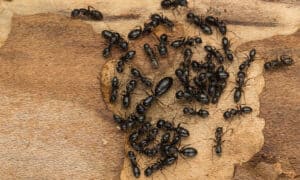There are over 20 quadrillion ants in the world. That is nearly 2.5 million ants for every human! Ants can be found in every place on Earth except for Antarctica, Greenland, and Iceland! And the state of Utah is no exception. With warmer temperatures and longer days, a diverse array of ants are set to emerge in Utah from their hidden colonies, bustling with life and intricate social structures. These tiny yet industrious insects are masters of cooperation and ingenuity, showcasing an astonishing variety of behaviors and adaptations. In this article, I will break down five types of ants in Utah that are set to emerge this summer.

1. Carpenter Ant (Camponotus)

Carpenter ants are one of the most common species of ant in Utah.
©Erik Agar/Shutterstock.com
In Utah, you’ll come across the largest type of ant, the carpenter ant. These ants are the most prevalent in the state and come in various colors, including black, brown, and red. Some even display a subtle striped pattern on their abdomens. The workers in a carpenter ant colony can range in size from small at about 1/4 inch to large at around 1/2 inch. On the other hand, the queens of these ants can grow as large as 3/4 inch.
Carpenter ants have diverse eating habits. They consume both dead and living insects and enjoy indulging in the honeydew excreted by other insects and sweets like honey.
When it comes to nesting, carpenter ants prefer wood, especially decaying wood. They establish their primary nests in such locations but also create separate satellite nests. These satellite nests may even be found indoors. The ants send out foragers who venture out to search for food and nutrients, but they always return to the main outdoor nest.
In Utah, carpenter ants are particularly active during the spring when conditions are wet, making it their prime time for reproduction and nesting. It’s rare to spot them during winter as they tend to disappear in the fall season.
2. Harvester Ant (Pogonomyrmex)

Harvester ants build massive ant hills and can be found in backyards.
©Kessler Bowman/Shutterstock.com
One of the most common types of ants in Utah is the harvester ant. They behave differently than other ant species, such as carpenter ants. While they don’t generally infest properties, they can establish colonies in your yard.
These ants vary in size, typically measuring between 1/4 to 1/2 inches, and display various colors from red to brown and black. Notably, they have a unique characteristic: a two-segmented pedicel that connects their thorax and abdomen, along with spines on their midsection.
Feeding primarily on gathered seeds, harvester ants also consume small insects and arthropods, whether dead or alive.
When it comes to nesting, harvester ants prefer dry, sandy to hard soils. They may relocate their nests occasionally in response to climate changes. These nests can reach depths of up to 3 feet and have multiple entrances.
In Utah, encountering harvester ants is a common occurrence, particularly during their swarming season from June to October. Interestingly, these ants are most active after rainfall, often emerging in the afternoon to explore their surroundings.
3. Pavement Ant (Tetramorium caespitum)

Pavement ants typically emerge in the spring and are most active between March and May.
©Ezume Images/Shutterstock.com
Prevalent in Utah, pavement ants are the primary nuisance ants found in and around buildings. These ants have workers of uniform size, and each colony is governed by a single queen.
With their brown to black bodies complemented by lighter legs and antennae, pavement ants possess a distinctive appearance. Their waist consists of two nodes, while their 12-segmented antennae end with a club composed of three segments. Notably, their head and thorax display parallel ridges or grooves. These ants are relatively small, measuring around 1/8 to 3/16 inch in length.
Pavement ants have a varied diet, but they exhibit a preference for sweet and greasy foods. They tend to establish their habitats beneath rocks and within wall voids, favoring areas with moisture.
On occasion, pavement ants may cause harm to plants. Indoors, these ants tend to be most problematic during the spring and early summer. Typically active from late winter until late fall, pavement ants engage in mating flights primarily during the spring through early summer, especially after periods of rainfall.
4. Pharaoh Ant (Monomorium pharaonis)
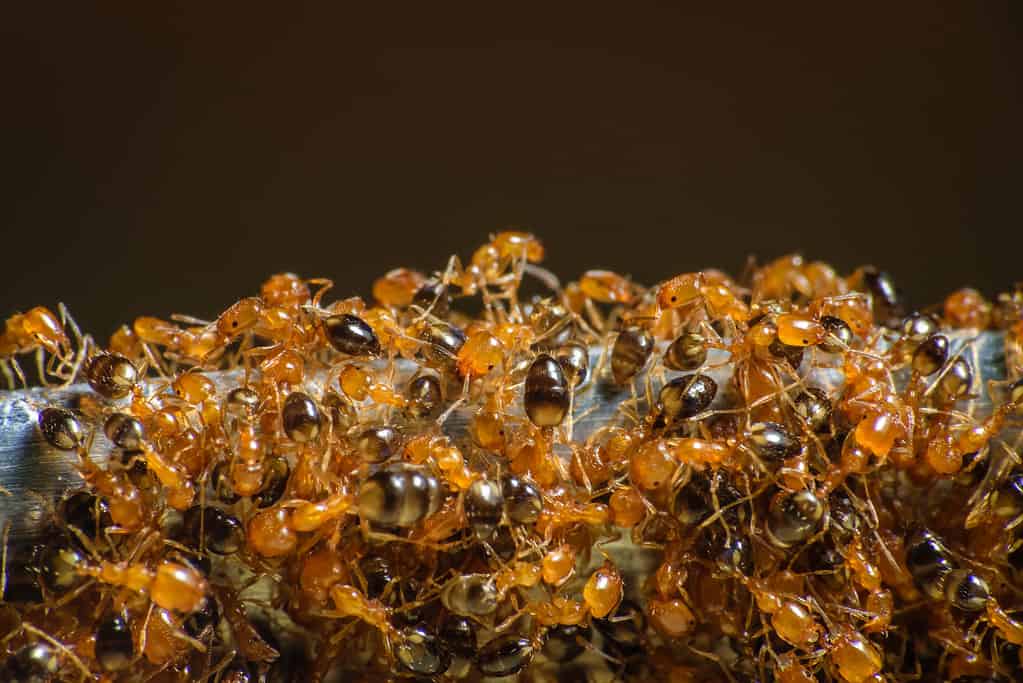
Pharoah ants are light in color and will eat anything in their path.
©Suman_Ghosh/Shutterstock.com
In Utah, homeowners frequently encounter pharaoh ants inside their houses, making them one of the most common ant species found indoors in the region.
These tiny ants range in size from around 1/16-inch to 3/32-inch and exhibit a variety of body colors, from light yellow to red, with distinctive red or black abdomens. The queens of this species usually have darker coloration compared to the worker ants.
Pharaoh ants can pose significant issues when they invade homes, as they have a broad diet, consuming everything from dead insects to grease and dog food. They exhibit nesting behavior within household structures, such as inside hollow curtain rods, behind baseboards, wall and cabinet voids, in refrigerator insulation, and even within clothes, folds of sheets, or paper. Outdoors, they establish nests in debris or cracks and crevices.
Remarkably, pharaoh ant colonies can be quite extensive, containing up to 300,000 workers and multiple queens.
One unfortunate aspect is that these ants can remain active throughout the year, as they prefer to nest inside buildings and homes. However, in Utah, their peak activity aligns with other ant species, and they are commonly observed outdoors between April and October.
5. Velvety Tree Ant (Liometopum occidentale)
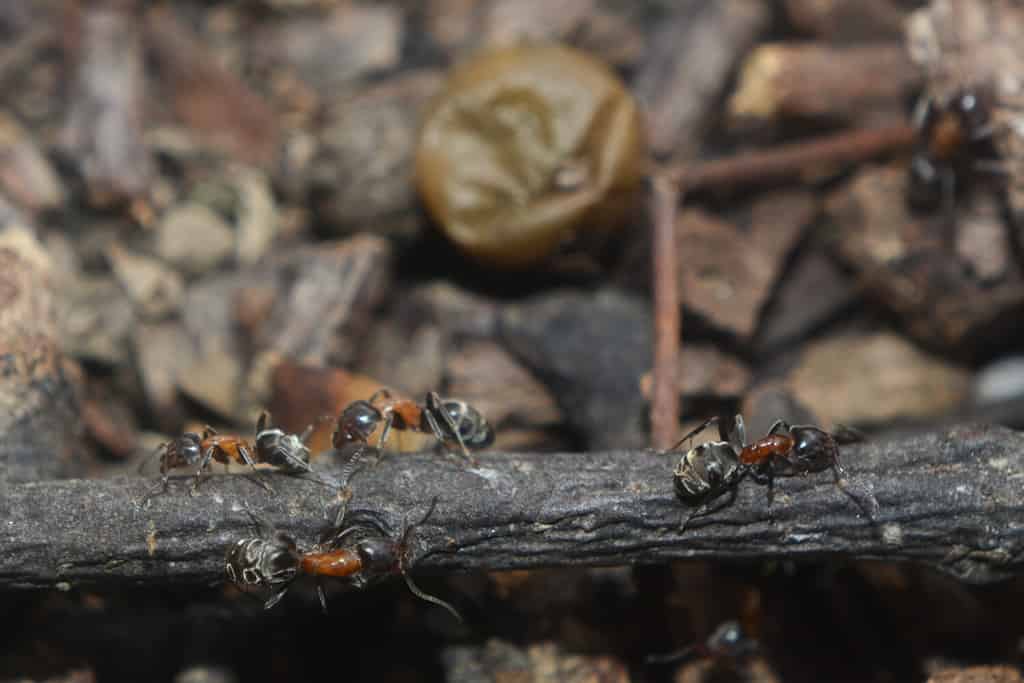
Velvety tree ants are typically found in the woods and have a painful bit.
©Vincent Grebenicek/Shutterstock.com
The final type of ant in Utah is the velvety tree ant. Velvety tree ants earned their name due to their smooth and velvety dark abdomens, which give them a distinct appearance. These ants have a striking appearance with velvety black abdomens, dark heads, and a reddish thorax. They are relatively small, ranging in size from 1/10th to ¼ inch. What makes them truly captivating is their colorful body.
Being omnivorous, velvety tree ants have a diverse diet that includes both plants and animals. They feed on insects, plants, honeydew, wood, and carrion.
These ants prefer to nest in dead wood within trees, stumps, and logs. However, they also construct temporary nests indoors when foraging. Inside buildings, their nests can be found in wall voids, insulation, and areas with high moisture. In outdoor settings, they seek shelter under loose bark and rocks.
Velvety tree ants display aggression when threatened, delivering a painful bite and spraying secretions onto intruders. Their defensive behavior serves as a deterrent. Not only do these ants cause discomfort through their bites, but they can also cause damage to insulation and wood by tunneling through them.
In Utah, the arrival of spring marks the reappearance of velvety tree ants, and they tend to remain active until September or October.
Other Insects Set to Emerge in Utah
While summer in Utah brings ideal weather for outdoor activities, it also welcomes the presence of various insects. Here are a few examples.
1. Western Boxelder Bug (Boisea rubrolineata)
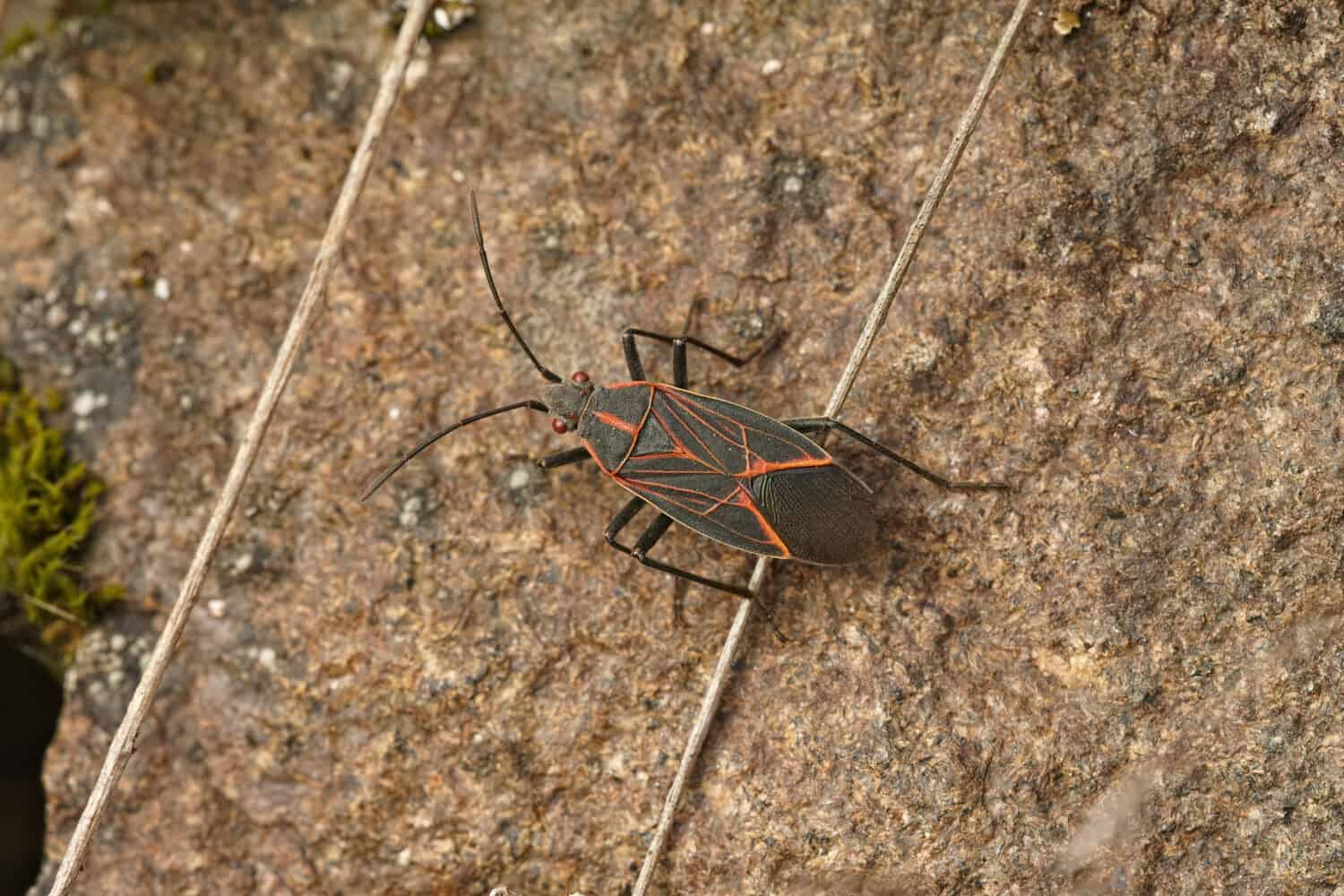
Around boxelder, ash, and maple trees, you may see western boxelder bugs in Utah.
©HWall/Shutterstock.com
The western boxelder bug is a common insect often found in Utah, particularly around boxelder, ash, and maple trees. These bugs, which are small and dark brown or black in color, may be seen both inside and outside homes.
Adult western boxelder bugs are flat and elongated, measuring between 3/8 and 5/8 inches in length. They have a gray-brown to black body with distinct red lines on their thorax and wing covers. Their underside is dark orange, making them easily noticeable when they are flying. The head and antennae of these bugs are black in color.
While Western boxelder bugs can reproduce rapidly, they are mainly considered to be a nuisance pest and do not cause significant structural damage. Fortunately, they also pose no health risks to humans.
These bugs are attracted to warm and dry environments, which explains their prevalence in Utah. Consequently, you may observe them congregating on the exterior of homes during the spring. As temperatures cool down in the fall, they typically retreat and disappear.
2. Western Conifer Seed Bug (Leptoglossus occidentalis)
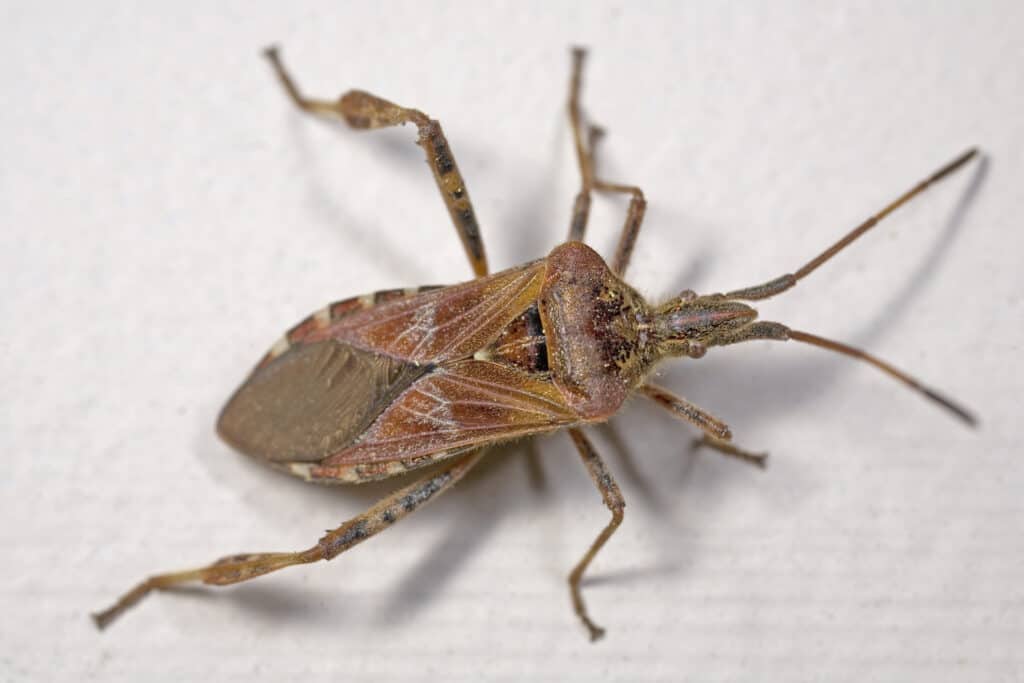
Western conifer seed bugs have white zig-zag stripes under their wings.
©iStock.com/jscalev
The pine seed bug, also known as the western conifer seed bug, is commonly found inside homes in Utah.
This robust insect measures about ¾ inch long and has a reddish brown body with a distinct white zigzag line across its wings. Interestingly, it possesses long back legs that have leaf-like enlargements on them, although they are not used for jumping.
Luckily, the western conifer-seed bug is harmless to property and is more of a nuisance. It tends to be attracted to the sunny sides of buildings and enters homes through cracks, gaps around windows and doors, and siding.
One of its main defense mechanisms is emitting an unpleasant-smelling alarm pheromone. However, if it is handled roughly, it may use its proboscis to stab, although it is unlikely to cause any harm to humans.
From late May to early June, the adult bugs emerge from their overwintering sites. The previous generation dies off by the end of summer, and the new adults start searching for warm places to spend the fall and winter months.
3. Colorado Potato Beetle (Leptinotarsa decemlineata)
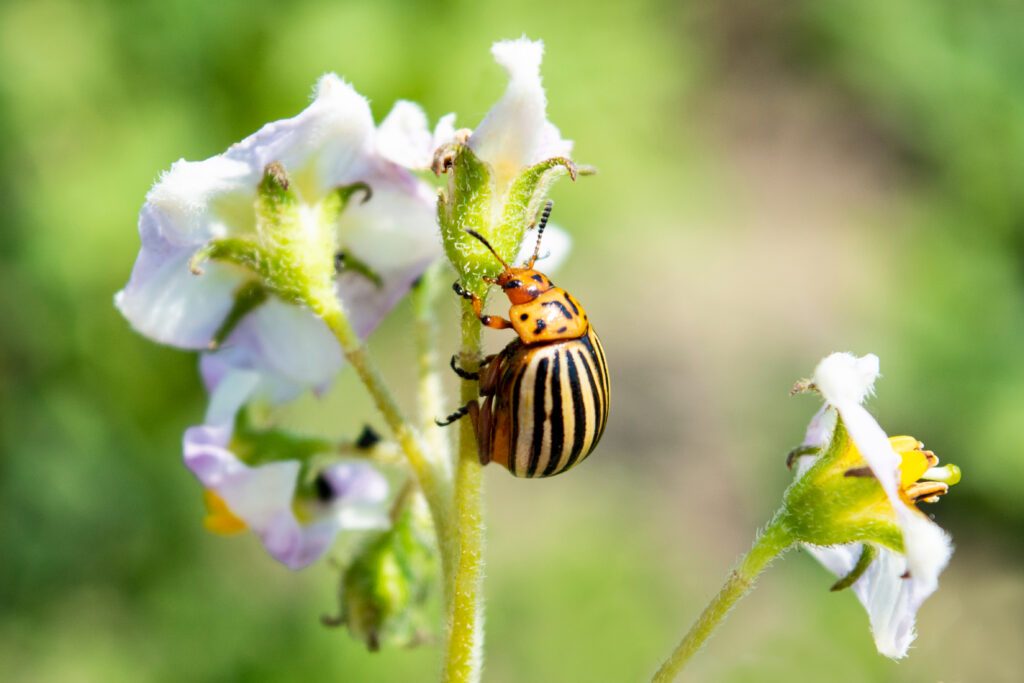
Potato beetles are a yellowish-orange color with black stripes.
©Mr. Background/Shutterstock.com
The Colorado potato beetle poses a significant threat to potato crops across North America.
The larvae of the Colorado potato beetle have a shiny reddish bronze color with a hump-back shape, measuring up to 1/2″ in length. They display two rows of black spots on each side. On the other hand, the adults exhibit a distinct appearance with their yellow and black striped bodies. Their wing covers are adorned with ten black stripes running along their length.
When feeling threatened, adult Colorado potato beetles are capable of biting, so caution is advised. Although their bite is not venomous, it can cause considerable pain.
This pest is a major concern for eggplants, potatoes, and peppers in home gardens and commercial agricultural production. If left unchecked, the Colorado potato beetle can completely strip the plants of their leaves, leading to significant yield losses and even plant death.
During the winter months, adult beetles seek shelter by burrowing into the ground of harvested potato fields. They can hibernate at depths ranging from four to twelve inches. In the following spring, typically around May, they emerge from their wintering grounds.
4. Mormon Cricket (Anabrus simplex)

It is rare for Mormon crickets to infest residential spaces.
©iStock.com/Triggermouse
The shield-backed katydid, known as the Mormon cricket, got its name from the Mormon settlers who encountered these insects while venturing westward in Utah. They played a significant role in the miracle of the gulls.
Measuring between 1.5 to 2 inches in length, the Mormon cricket exhibits various shades of gray, green, purplish, brown, and black. Its hind tibiae are adorned with spines, and while it possesses underdeveloped wings, it cannot fly.
Homeowners need not be overly concerned about Mormon crickets invading their houses. Although they may swarm, it is rare for them to infest residential spaces. These insects do not pose a direct threat to humans, aside from their creepy appearance and the potential slipperiness they cause on roads. However, they can wreak havoc on crops and vegetation, leading to significant damage.
Mormon crickets become pests sporadically, typically occurring once or twice in a decade when their population reaches high levels, triggering large-scale migrations. If an alfalfa field happens to lie in the path of their migration, the Mormon crickets can inflict severe harm by devouring the plants.
Typically, these insects remain active in Utah from March or April until August or September.
Summary of the Types of Ants Set to Emerge in Utah
| Ant | Month to Emerge | |
|---|---|---|
| 1 | Carpenter Ant | April – October |
| 2 | Harvester Ant | June – October |
| 3 | Pavement Ant | March – November |
| 4 | Pharaoh Ant | April – October |
| 5 | Velvety Tree Ant | April – September/October |
The photo featured at the top of this post is © Yuphayao Pooh's/Shutterstock.com
Thank you for reading! Have some feedback for us? Contact the AZ Animals editorial team.




